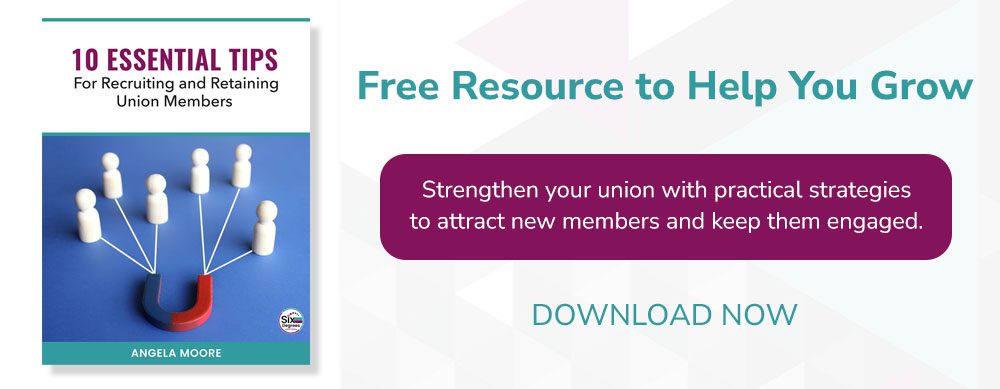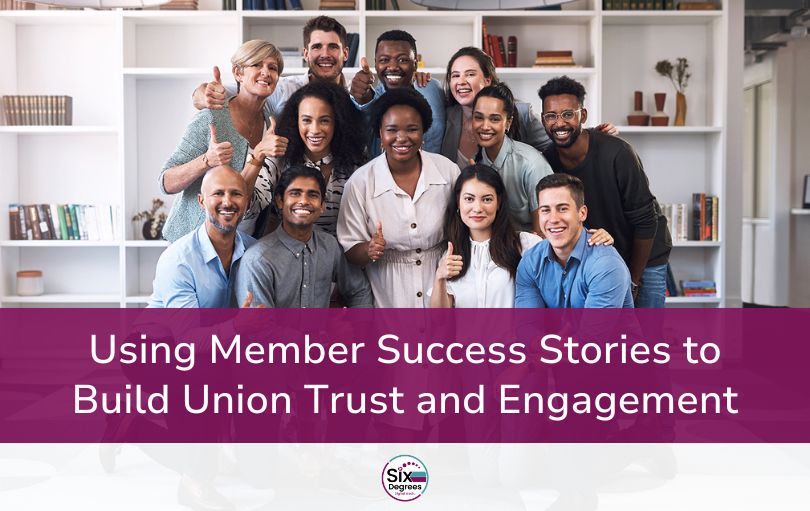In the ever-evolving digital landscape, the echo of every keystroke can either amplify or dampen your union’s voice. 📢 Now, more than ever, a robust online presence isn’t just beneficial; it’s imperative. Think of it not just as building an online profile but as crafting a digital megaphone that reaches far beyond traditional means.
This step-by-step guide is designed to walk you through the essential stages of establishing a strong online foothold. From setting clear, actionable goals to effectively engaging with your community through sophisticated platforms and tools, we’ll cover it all. Each step is tailored to ensure that your union not only steps into the spotlight but shines in it. 🌟
Whether you’re looking to rally support, increase membership engagement, or advocate for policies, these strategies will equip you with the necessary tools to make a significant impact. So, roll up your sleeves (metaphorically speaking!), and let’s start building an online presence that truly represents the strength and unity of your organization.
Step 1: Define Your Goals and Audience
Before diving into the digital realm, it’s crucial to anchor your strategy with clear goals and a deep understanding of whom you’re speaking to. 🎯 Just like in a well-planned campaign, knowing what you want to achieve and who your messages are for will determine the strength of your online presence.
Identifying Objectives for Your Online Presence
Start by asking the fundamental questions: What do we want to achieve with our online presence? Is it boosting membership, influencing policy changes, or enhancing member engagement? Setting these goals provides a roadmap and helps measure success down the line. It’s like setting the destination in your GPS before starting your journey. 🗺️
Think about both immediate needs and long-term aspirations. Perhaps you want to establish authority in your space or serve as a primary resource for current and potential members. Or maybe, the goal is to foster a stronger community through interactive platforms. Whatever the objectives, make them SMART: Specific, Measurable, Achievable, Relevant, and Time-bound.
Understanding Your Target Audience and Their Needs
Now, turn your focus to those you aim to reach: your members and potential members. Who are they? What challenges do they face? How do they prefer to receive information? This step is about creating personas that represent your typical audience members – think of it as sketching a detailed character in a novel. 📚
For instance, younger members might be more engaged through dynamic social media content or mobile apps, while older demographics might prefer emails or web articles. Understanding these preferences is pivotal in crafting messages that resonate and engage.
By aligning your objectives with the needs and habits of your target audience, you create a focused strategy that’s not just seen but felt. Every tweet, post, or update becomes a step towards those defined goals.
Step 2: Build a User-Friendly Website
Imagine walking into a well-organized rally; the messages are clear, the path is direct, and everyone feels welcomed and understood. That’s the vibe your union’s website should emit. In today’s digital first environment, your website acts as the headquarters of your online presence. 🌐 Here’s how to ensure it’s built not just to impress, but to perform.
Essential Elements of a Union Website
First and foremost, accessibility is key. Ensure that your website is ADA compliant, meaning it’s navigable for all users, including those with disabilities. This inclusivity reflects your union’s values of fairness and equality.
Next up, security. Given the sensitive nature of the information often handled by unions, robust SSL certificates and HTTPS are non-negotiables to protect your members’ data. 🔒
Your website should also integrate seamlessly with social media platforms to amplify reach and engagement. Include clear call-to-action (CTA) buttons—like ‘Join Us’, ‘Learn More’, or ‘Contact Us’—positioned prominently on every page.
Finally, a dedicated news or blog section can keep members updated on recent activities, upcoming events, and critical issues, ensuring your site remains a go-to resource for relevant information.
Tips for Effective Web Design and User Experience
- Responsive Design: Your site should look good on any device, from desktops to smartphones. With more people accessing information on-the-go, a mobile-friendly design isn’t just nice to have; it’s essential. 📱
- Easy Navigation: Menus should be intuitive; users shouldn’t need to hunt for information. A clean, logical layout helps users find what they need quickly and effortlessly.
- Fast Load Times: Patience is a limited commodity online. Optimize image sizes and streamline code to ensure quick loading times. Remember, faster sites are also ranked better by search engines.
- Engaging Visuals: Incorporate photos and videos of real members and union activities. Authentic visuals not only draw attention but also help forge a stronger connection with your audience.
- Regular Updates: Keep content fresh and dynamic by regularly updating it. Outdated information can make your site seem neglected and can deter potential members.
Ready to transform your online presence? Let’s make your website not just functional but fabulous! 💪
Step 3: Create Valuable and Engaging Content
Content is the heartbeat of any effective online strategy. For unions, where the spirit of collective action and community is vital, it becomes even more critical to craft content that not only informs but also energizes and mobilizes members. 📣 Here’s how to create content that resonates and keeps the conversation going.
Types of Content That Resonate with Union Members
- Educational Articles: Provide insights into rights, changes in laws, and industry updates. Empowering members through knowledge helps foster a proactive community.
- Success Stories: Highlight wins, big or small. Showcasing real-life examples of advocacy and triumph promotes a sense of unity and achievement within your membership.
- Video Content: From detailed explanations of benefits to heartwarming member stories, videos are powerful in conveying emotion and driving engagement. 🎥
- Infographics: Complex data about negotiations, benefits, or legal changes can be made digestible through well-designed infographics.
- Interactive Content: Polls, surveys, and quizzes can keep members engaged, provide valuable feedback, and make them feel heard.
Strategies for Consistent Content Creation and Distribution
Creating great content is just the start; ensuring it reaches your audience effectively is key to real impact.
- Content Calendar: Plan your content in advance with a comprehensive calendar that covers important dates, campaigns, and events. This keeps your messaging timely and relevant.
- Multi-Channel Distribution: Each piece of content should be optimized for the platform it’s shared on. Use your website for in-depth articles, social media for quicker updates and engaging visuals, and email newsletters to summarize key information monthly or weekly.
- Member Contributions: Encourage content creation from within your membership. This not only lightens the load on your content team but also adds authenticity and variety to your output.
- Regular Reviews: Utilize analytics to track what types of content perform best and refine your strategy accordingly. 📊
Ready to boost engagement through stellar content? Reach out today for a strategy session that brings results!
Step 4: Utilize Social Media Effectively
In today’s hyper-connected world, social media is the town square where conversations happen, opinions are formed, and movements grow. For unions, these platforms offer a vital channel to reach members, rally support, and drive change. But like any tool, it’s all about how you use it. 🛠️ Here’s how to make social media work for your union.
Choosing the Right Social Media Platforms
Not all social media platforms are created equal, especially when it comes to engaging with union members. It’s essential to select platforms based on where your members are most active and the kind of interaction each platform fosters:
- Facebook: Great for community building and news sharing, with tools for creating groups and hosting live events.
- Twitter: Ideal for real-time communication and updates, perfect for advocacy and reaching out to a broader audience.
- Instagram: Effective for visual storytelling through photos and videos, useful for highlighting member stories and key moments from rallies or events.
- LinkedIn: Provides a professional angle, suitable for networking and discussing industry-specific issues.
Best Practices for Social Media Engagement and Outreach
- Consistent Posting: Keep your audience engaged by maintaining a regular posting schedule. This doesn’t mean bombarding them with content but providing steady, valuable updates that keep them connected and informed.
- Engage in Conversations: Social media is a two-way street. Don’t just broadcast; interact. Respond to comments, participate in relevant discussions, and show that you value member input. This builds trust and fosters a more engaged community.
- Use Hashtags Wisely: Hashtags can extend your reach but use them judiciously. Research popular and relevant hashtags in your sector to ensure your content is discoverable by those interested in your cause.
- Monitor and Adapt: Use social media analytics tools to track what works and what doesn’t. This data can guide your strategy and help optimize your future posts for better engagement.
- Promote Action: Whether it’s signing a petition, attending a webinar, or joining a protest, use clear calls-to-action to transform online support into real-world impact.
Ready to elevate your union’s social media presence? Let’s strategize together to make every post count! 💬
Step 5: Optimize for Search Engines (SEO)
In the vast ocean of the internet, ensuring your union’s website can be easily found by search engines is akin to setting up a lighthouse that guides ships to shore. SEO is that lighthouse, ensuring that when someone searches for anything related to your union’s cause or services, your website shines brightly at the top. Let’s demystify SEO and make it work for your union. 🌐💡
Basic SEO Techniques to Improve Visibility
- Keywords: Identify the most relevant and frequently searched keywords associated with your union’s activities. Incorporate these naturally into your titles, headers, and content to improve relevancy and visibility.
- Meta Descriptions: These brief descriptions appear under your web page titles in search results. Write clear, compelling meta descriptions that include key phrases and encourage clicks.
- Mobile Optimization: With the increasing use of mobile devices, ensure your website is mobile-friendly. Google prioritizes mobile-optimized sites in its search rankings.
- Quality Content: Regularly update your site with high-quality, original content that provides value to your audience. This not only engages users but also increases your site’s authority and relevance in search results.
- Alt Text for Images: Enhance accessibility and SEO by adding alt text to images. This helps search engines understand the images on your site, improving the likelihood they’ll contribute to your SEO efforts.
Importance of Local SEO for Unions
Local SEO is crucial for unions because many of their activities are community-centered. By optimizing for local SEO, you ensure that your union shows up in search queries specific to your area, making it easier for local members and supporters to find you.
- Google My Business: Registering your union with Google My Business can significantly boost local visibility. Ensure your listing is complete with accurate contact information, address, and operating hours.
- Local Keywords: Use location-specific keywords in your content, such as the city or region where your union is active.
- Local Backlinks: Gain links from other local businesses and organizations to boost credibility and local search rankings.
Ready to boost your online presence? Connect with us for a personalized strategy session that turns searches into engagement!
Step 6: Leverage Email Marketing
Email marketing remains a powerhouse in the toolkit of digital communication, especially for engaging directly and personally with your community. With the right strategy, you can transform a simple email into a compelling narrative that resonates, informs, and mobilizes your audience. 💌 Let’s check out how to build and segment your email list and craft impactful campaigns that spark action.
Building and Segmenting Your Email List
- Opt-In Forms: Ensure that your website and social media channels have visible, easy-to-use opt-in forms. Encourage sign-ups by offering value, whether it’s exclusive content, a first look at new resources, or updates on important initiatives.
- Segmentation: Once you have a growing list, segment it based on criteria like interests, engagement levels, or demographic details. This tailored approach allows you to send more personalized and relevant emails that are more likely to be opened and acted upon.
- Compliance: Always adhere to regulations like GDPR or CAN-SPAM to build trust and maintain the integrity of your email marketing practices.
Crafting Impactful Email Campaigns
- Compelling Content: Start with a catchy subject line to ensure your email gets opened. The content should be concise and focused, with a clear message that reflects your audience’s needs and interests.
- Strong Call-to-Action (CTA): Every email should have a clear CTA, whether it’s inviting members to attend a webinar, participate in a survey, or join a movement. Make the action simple and straightforward.
- Test and Optimize: Use A/B testing for subject lines, CTAs, and even send times to see what works best with your audience. Regularly review the performance metrics like open rates and click-through rates to continually refine your approach.
- Consistent Scheduling: Maintain regular contact with your audience but avoid overwhelming them. A consistent schedule keeps your audience engaged without causing fatigue.
Looking to elevate your email marketing game? Connect with us today for a strategy session that brings real results!
Step 7: Monitor and Analyze Your Efforts
In the world of digital marketing, setting campaigns into motion isn’t the end of the road; it’s just the beginning. To truly navigate the effectiveness of your efforts, ongoing monitoring and analysis are crucial. This continuous loop of feedback and adjustment can turn good strategies into great ones, ensuring your campaigns resonate well with your audience and meet predefined goals. Here’s how to keep your finger on the pulse of your digital marketing efforts. 🔍📊
Tools and Metrics for Tracking Online Performance
- Analytics Platforms: Utilize tools like Google Analytics for a comprehensive view of your website’s traffic, user behavior, and engagement metrics. These platforms offer insights that help you understand which parts of your strategy are working and which aren’t.
- Social Media Analytics: Platforms like Facebook Insights and Twitter Analytics provide data specific to social engagements. This includes likes, shares, comments, and demographic information about your audience.
- Email Marketing Metrics: Tools integrated into email marketing platforms can track open rates, click-through rates, and conversions. This data is invaluable for refining your email strategies to boost engagement.
- SEO Performance Tools: Utilize SEO tools like SEMrush or Ahrefs to track keyword rankings, backlink growth, and competitor analysis. These insights are crucial for adjusting your SEO strategies to improve visibility and ranking.
Adjusting Strategies Based on Data Insights
- Adapt Content: If certain blog posts or topics generate more traffic or engagement, consider creating more content on those subjects or using similar formats.
- Refine Keywords: If some keywords bring more organic traffic than others, adjust your content to focus more on those terms.
- Optimize Campaign Timing: Analyze when your audience is most active online and adjust your posting schedule accordingly to increase engagement.
- Personalize Emails: Segment your email list further based on user behavior and preferences indicated by open rates and interaction data. Tailored emails can significantly increase relevance and response rates.
Eager to see how analytics can transform your marketing strategies? Schedule a free strategy session with us today, and let’s decode the data together!
Conclusion: Solidifying Your Online Presence
As we’ve navigated through the essential steps to build a robust online presence, it’s clear that each element plays a vital role in connecting with your audience effectively. From engaging content creation to leveraging social media, optimizing for search engines, utilizing email marketing, and consistently monitoring and analyzing your efforts, these strategies are key to enhancing your digital footprint.
We’ve seen how tailored content can attract and retain attention, how strategic social media usage can foster community, and how SEO ensures you are seen by those who matter most. Email marketing continues to be a direct line to your audience, providing personalized interactions, while ongoing analysis guarantees that no effort is wasted and every strategy is primed for success.
Now, imagine amplifying these strategies with expert guidance tailored specifically to your needs. 🌟 Whether you’re diving deeper into AI integration or refining your digital marketing strategies, our team is here to help you navigate these complex waters.
Ready to transform your online presence into a beacon of success? Schedule a free strategy session with us today. Let’s explore how we can tailor our expertise to your unique challenges and goals, ensuring your digital marketing efforts deliver maximum impact. Together, we’ll ensure that your brand not only survives but thrives in the digital landscape. 🚀






